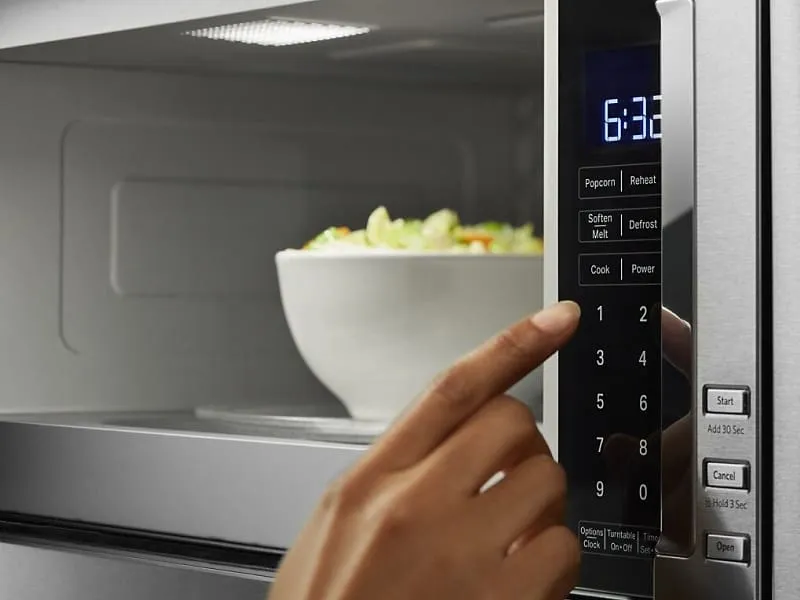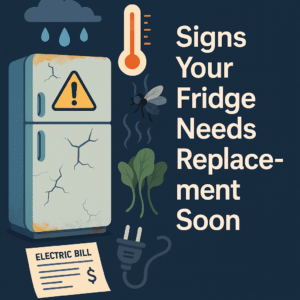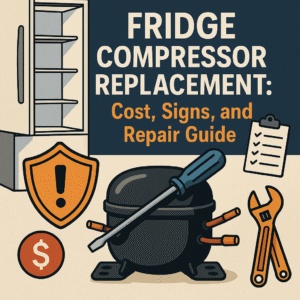Microwave not heating? We know how frustrating it can be when your microwave oven turns on but won’t heat your food. It can ruin dinner plans and slow down your kitchen routine. Luckily, many causes are simple to fix. In this guide, we explain the most common reasons a microwave oven stops heating – from user settings to faulty components – and share easy microwave repair tips to help you solve the problem or know when to call a professional.
For instance, Whirlpool notes that user settings like Control Lock, Demo Mode, or a too-low power level can make a microwave appear to run without heating, while hardware failures like a broken magnetron, door switch, or high-voltage diode are often the culprit. Read on to learn what to check and how to fix it.

Why Is My Microwave Not Heating?
If your microwave isn’t heating, the first step is to troubleshoot. Some issues are simple settings or power problems, while others involve internal components. Below are the most common causes of a microwave not heating. We’ll cover each one with easy-to-follow tips.
1. Door Switch Problems
Modern microwaves have safety switches on the door to ensure the unit stops operating when the door is open. If a door switch is faulty or the door isn’t latching properly, the microwave may run (lights and turntable may work) but won’t heat food. You might notice the interior light not turning on/off correctly, or that the door feels loose.
- Check the door latch: Make sure the door closes fully and the latch engages properly. A partially open door can prevent heating.
- Inspect and test switches: Over time a switch can wear out. Use a multimeter (with the microwave unplugged) to test each switch for continuity. A switch that doesn’t show continuity when the door is closed is likely faulty.
- When in doubt, replace the switch: If the microwave still won’t heat, a defective door switch is a common culprit and relatively inexpensive to replace.
Oven Not Heating Up? Troubleshooting Tips & Solutions Complete Guide. Click Here!

2. Magnetron Failure
The magnetron is the heart of your microwave – it generates the microwaves that heat food. If the magnetron burns out or blows an internal fuse, the microwave will turn on but not heat. Magnetrons often make a buzzing noise when failing and can even smell burnt.
- Listen for unusual sounds: A humming or buzzing that stops after a short while can indicate a failing magnetron.
- Check for error or burned parts: Some microwaves show an error code or emit a burnt smell if the magnetron is bad.
- Replace or call a pro: Testing or replacing a magnetron requires special tools and safety precautions. Because magnetrons are expensive and carry high voltage, it’s usually best to have a technician handle this. In fact, fixes that involve a failed magnetron often cost nearly as much as a new microwave.
3. High-Voltage Diode Failure
The high-voltage diode converts AC power to DC for the magnetron. If it fails (burns out or shorts), the magnetron won’t get enough voltage and the microwave won’t heat. A bad diode can also cause the microwave to trip breakers or create a buzzing sound.
- Listen and smell: A failing diode may cause a buzzing sound or burnt odor when you try to run the microwave.
- Test the diode: Unplug the microwave and carefully use a multimeter on the diode. It should conduct in only one direction; if it shows continuity both ways or none at all, it needs replacement.
- Handle with care: High-voltage parts are dangerous. Always discharge the capacitor first or have a professional perform this test.

4. High-Voltage Capacitor Issues
The high-voltage capacitor stores electrical energy and releases it to the magnetron, ensuring it gets the roughly 4,000 volts it needs. If the capacitor is faulty, the microwave won’t heat and may make strange humming or crackling noises.
- Look for leaks or bulges: A damaged capacitor might have visible leaks, bulges, or burn marks.
- Beware strange smells: A burning or chemical odor can indicate a failed capacitor.
- Test and replace carefully: Testing requires discharging the capacitor first. If it fails a capacitance test or shows leakage, it should be replaced. Due to the high voltage, this is usually a job for an experienced repairer.
5. Blown Thermal Fuse or Other Fuse
A thermal fuse (or cut-off) prevents the microwave from overheating. If this fuse blows, the microwave will lose heating power.
- Check for a blown fuse: Unplug the microwave and open the cover. Find the thermal fuse (often near the transformer or control board). Test it with a multimeter – an open fuse means it’s blown.
- Replace if needed: If the fuse is open, replace it with the exact type for your model. Make sure to use the correct part; microwave fuses are not the same as home electrical fuses.
6. Control Lock and Settings Issues
Sometimes the microwave seems fine but won’t heat due to user settings or modes. Whirlpool points out that Control Lock Mode, Demo Mode, or a low power setting can prevent cooking. In these cases, the microwave may spin, light up, and even run the fan, but not activate the magnetron.
- Disable Control Lock: Press and hold the “Cancel/Off” button (check your manual) until the lock icon (often “LOC” or “L”) clears.
- Exit Demo or Delay Mode: Unplug the microwave for a minute to clear a demo or delayed-start setting. Then reset the controls and try again.
- Set power to 100%: Ensure the microwave power level is at high (100%). A low power setting will heat food very slowly, making it seem like it’s not heating at all.

7. Power Supply and Outlet Problems
It may sound obvious, but make sure your microwave is actually getting power. If nothing happens when you press Start, first check the basics:
- Ensure it’s plugged in: Unplug and re-plug the microwave to reset it. Confirm the outlet works by testing another appliance in it.
- Check the breaker: Look in your home’s circuit breaker panel to see if the microwave’s breaker has tripped.
- Try a different outlet: If possible, plug the microwave into another outlet (or use a voltage tester) to rule out a faulty circuit or GFCI outlet.
If you’ve tried all the above and your microwave still won’t heat, the fault is likely with an internal component. At that point, it’s wise to call a professional. Whirlpool advises that for complicated parts issues (like a bad magnetron or diode), you should contact a repair technician.
Frequently Asked Questions
Why is my microwave running but not heating?
If your microwave powers on (lights and turntable work) but won’t heat, the problem is often one of the causes above. First check easy fixes: power settings (ensure 100% power), control locks (disable lock or demo mode), or a delay timer. If it still won’t heat, common culprits include a faulty door switch, magnetron, diode, or thermal fuse. For example, a bad door switch can prevent the heating cycle even though the oven appears to run. If you’ve ruled out basic issues, a trained technician can diagnose the specific part failure.
What parts commonly fail in a microwave that won’t heat?
When a microwave stops heating, the issue is usually one of a few key components failing – often called common broken microwave causes. For example, Whirlpool notes that a defective magnetron or broken high-voltage diode are frequent culprits. The typical failing parts include:
- Magnetron: Generates the microwaves. If it fails, the microwave will turn on but produce no heat.
- High-Voltage Diode or Capacitor: These power the magnetron. A burned diode or shorted capacitor stops the magnetron from heating.
- Door Switches: Any one of the door switches can fail, cutting power to the magnetron even if the oven seems to run.
- Thermal Fuse: If the thermal (or other) fuse blows from overheating, the microwave will shut off heating entirely.
Is it safe to repair a microwave myself, or do I need a professional?
Microwaves contain dangerous high-voltage components. Even after unplugging, the high-voltage capacitor can hold a lethal charge. For this reason, appliance makers and safety experts strongly discourage DIY microwave repairs unless you are trained. You can safely do some checks (reset breakers, check power settings, replace an easily accessible fuse), but tasks like testing or replacing the magnetron, diode, or capacitor should be done by a trained technician.
How much does it cost to fix a microwave that won’t heat?
Repair costs vary widely by the issue. Simple fixes (like replacing a switch or fuse) might be well under $100. However, replacing a magnetron or other high-voltage parts can run into the few hundreds. Because magnetrons and other components are expensive, a repair can cost almost as much as buying a new microwave. Always get an estimate – if the repair is more than half the cost of a new unit, replacement might make more sense.
Should I repair or replace my microwave if it’s not heating?
Microwaves typically last around 7 years. If your microwave is relatively new or the fix is inexpensive (like a fuse or switch), repairing it is worth it. But if the microwave is old and needs a costly part like a magnetron, replacement is often the better choice. Experts advise that if repair costs exceed about 50% of a new microwave’s price, buy new instead. Modern microwaves are more energy-efficient too, so consider a new model if your old one is aging. Need help with your microwave? Sarcon Appliance Repair is ready to assist. We offer expert, same-day microwave repair service in Hershey, Harrisburg, Camp Hill, Mechanicsburg, York and the surrounding areas. Contact us today to get your microwave heating again!





